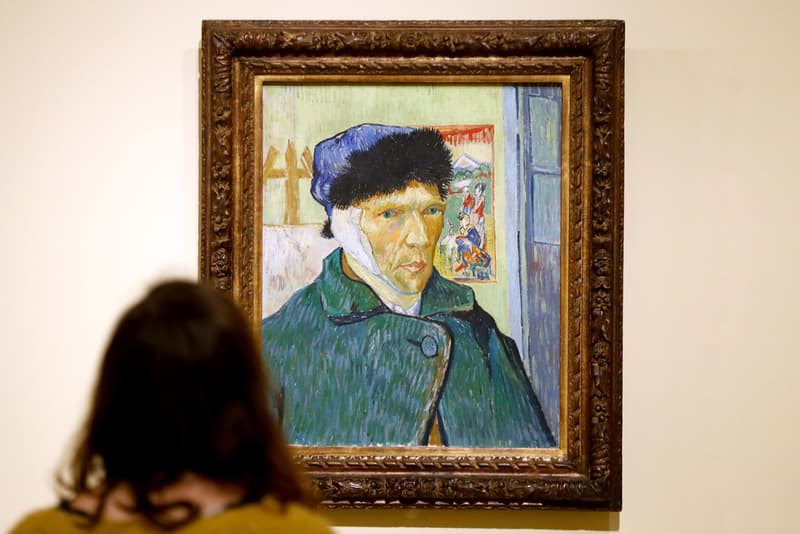Van Gogh's Bashfully Appreciative Letter to Art Critic Displayed in Amsterdam
For what might be the first time in history.

A letter Vincent van Gogh wrote to art critic Albert Aurier is now up on display at the Van Gogh Museum in Amsterdam for what might be the first time in history.
The enthusiastically thankful letter was penned by the prominent artist on either February 9 or 10, 1890, just before his death while he was an asylum patient on the outskirts of Saint-Rémy-de-Provence. The contents of the letter referred to Aurier’s piece for the Mercure de France magazine entitled Les Isolés, where he described Van Gogh’s work as “excess, excess in strength, excess in nervousness, violence in expression.” Van Gogh was elated with Aurier’s stellar review, even writing to his brother Theo and asking him to share it with all his friends and colleagues in the art world.
Calling Aurier’s piece as “a work of art in itself,” the artist wrote, “I feel that you create colours with your words; anyway I rediscover my canvases in your article, but better than they really are – richer, more significant.” However, he felt like he was not worthy of the praise. He advised Aurier to take a look at the works of fellow artists Adolphe Monticelli and Paul Gauguin, saying that his compliments are better-suited for their works rather than his. In the thought of giving Aurier a painting as a gift, Van Gogh also elaborates on his methods and emotions during his process, speaking on how slow the paint is expected to dry and the effects of Delacroix’s favorite shade of Prussian blue.
“It is a misconception that he wasn’t valued during his lifetime because at the end he was getting quite well known in certain artistic circles but he found that somehow hard to deal with. So there is a lot of mixed emotion. He is proud but also feeling that he is not there yet, not yet deserving of the praise,” museum curator Fleur Roos Rosa de Carvalho explained. She added, “It was on top of our list because it is such an important letter. Most of the letters on our wish list have sketches on them. This one has not, but the content of it is so moving and rich that we thought we should pursue it.”
The letter was secured at an auction last month at the €107,900 sale price from Hong Kong tycoon Cheung Chung-kiu and his wife, Cecilia. It trickled down the hands of private collectors around the world and was purchased by the shady Aristrophil investment scheme in 2007. Upon the closure of Aristophil and the fraud charges, the letter returned to the Paris market. “The great thing about it is that as far as we know it has hardly been shown in public. So this is the first time, we expect,” De Carvalho said.
Van Gogh died from an apparent suicide five months after this letter.
Read the transcript of the letter below.
In other art news, a rare Leonardo da Vinci portrait has been unearthed.
Dear Mr Aurier,
Thank you very much for your article in the Mercure de France, which greatly surprised me. I like it very much as a work of art in itself, I feel that you create colours with your words; anyway I rediscover my canvases in your article, but better than they really are – richer, more significant. However, I feel ill at ease when I reflect that what you say should be applied to others rather than to me. For example, to Monticelli above all. Speaking of “he is – as far as I know – the only painter who perceives the coloration of things with such intensity, with such a metallic, gem-like quality” – if you will please go and see a particular bouquet by Monticelli at my brother’s place – bouquet in white, forget-me-not blue and orange – then you will feel what I mean. But for a long time the best, the most astonishing Monticellis, have been in Scotland, in England. In a museum in the north however – the one in Lille I think, there must still be a marvel by him, far richer and certainly no less French than Watteau’s Departure for Cythera. At present Mr Lauzet is in the process of reproducing around thirty Monticellis. Here you have it, as far as I know there is no colourist who comes so straight and directly from Delacroix; and yet it is likely, in my opinion, that Monticelli only had Delacroix’s colour theories at second hand; in particular he had them from Diaz and Ziem. It seems to me that his, Monticelli’s, artistic temperament is exactly that of the author of the Decameron – Boccaccio – a melancholy man, an unhappy, rather resigned man, seeing high society’s party pass by, the lovers of his day, painting them, analysing them, he – the outcast. Oh! He does not imitate Boccaccio any more than Henri Leys imitated the primitives. Well, this was to say that things seem to have strayed onto my name that you would do better to say of Monticelli, to whom I owe a great deal. Next I owe a great deal to Paul Gauguin, with whom I worked for a few months in Arles, and whom, besides, I already knew in Paris.
Gauguin, that curious artist, that stranger whose bearing and gaze vaguely recall Rembrandt’s portrait of a man in the La Caze gallery, that friend who likes to make one feel that a good painting should be the equivalent of a good deed, not that he says so, but anyway it is difficult to spend time with him without thinking of a certain moral responsibility. A few days before we parted, when illness forced me to enter an asylum, I tried to paint “his empty place”.
It is a study of his armchair of dark, red-brown wood, the seat of greenish straw, and in the absent person’s place a lighted candlestick and some modern novels. If you have the opportunity, as a memento of him, please go and look a little at this study again, which is entirely in broken tones of green and red. You may perhaps then realise that your article would have been more accurate and – it would seem to me – thus more powerful – if in dealing with the question of the future “painting of the tropics” and the question of colour, you had done justice to Gauguin and Monticelli before talking about me. For the share that falls or will fall to me will remain, I assure you, very secondary.
And then, I would also have something else to ask of you. Supposing that the two canvases of sunflowers that are presently at the Vingtistes have certain qualities of colour, and then also that they express an idea symbolising “gratitude”. Is this any different from so many paintings of flowers that are more skilfully painted and which people do not yet sufficiently appreciate, père Quost’s Hollyhocks, Yellow Irises? The magnificent bouquets of peonies which Jeannin produces in abundance? You see, it seems to me so difficult to separate Impressionism from other things, I cannot see the point of so much sectarian thinking as we have seen these last few years, but I fear its absurdity.
And, in closing, I declare that I do not understand that you spoke of Meissonier’s infamies. It is perhaps from that excellent fellow Mauve that I have inherited a boundless admiration for Meissonier; Mauve was endless in his praise for Troyon and Meissonier – a strange combination.
This is to draw your attention to how much people abroad admire, without attaching the slightest importance to what unfortunately so often divides artists in France. What Mauve often repeated was something like this, “if you want to do colour you must also know how to draw a fireside or an interior like Meissonier”.
I shall add a study of cypresses for you to the next consignment I send to my brother, if you will do me the pleasure of accepting it as a memento of your article. I am still working on it at the moment, wanting to put in a small figure. The cypress is so characteristic of the landscape of Provence, and you sensed it when saying: ‘even the colour black’. Until now I have not been able to do them as I feel it; in my case the emotions that take hold of me in the face of nature go as far as fainting, and then the result is a fortnight during which I am incapable of working. However, before leaving here, I am planning to return to the fray to attack the cypresses. The study I have intended for you depicts a group of them in the corner of a wheat field on a summer’s day when the mistral is blowing. It is therefore the note of a certain blackness enveloped in blue moving in great circulating currents of air, and the vermilion of the poppies contrasts with the black note.
You will see that this constitutes more or less the combination of tones of those pretty Scottish checked cloths: green, blue, red, yellow, black, which once appeared so charming to you as they did to me, and which alas one scarcely sees any more these days.
In the meantime, dear sir, please accept my grateful thanks for your article. If I were to come to Paris in the spring I shall certainly not fail to come and thank you in person.
Vincent van Gogh
[PS:] When the study I send you is dry right through, also in the impasto, which will not be the case for a year – I should think you would do well to give it a good coat of varnish. And between times it should be washed several times with plenty of water to get out the oil completely. This study is painted in full Prussian blue, that colour about which people say so many bad things and which nevertheless Delacroix used so much. I think that once the Prussian blue tones are really dry, by varnishing you will obtain the dark, the very dark tones needed to bring out the different dark greens. I do not quite know how this study should be framed, but as I really want it to make one think of those dear Scottish fabrics, I have noticed that a very simple flat frame, bright orange lead, creates the desired effect with the blues of the background and the dark greens of the trees. Without this there would perhaps not be enough red in the canvas, and the upper part would appear a little cold.
Van Gogh Museum
Museumplein 6, 1071 DJ
Amsterdam, Netherlands












